- SELLING RESOURCES -
Listing your home
RESOURCES FOR:
This section walks through the things to know when listing your home.
JUMP TO
YELLOW SAYS...
HERE'S THE SALE PROCESS ON YELLOW
Use this Resources section or contact us for any help along the way!
- INSPECTION -
This is the only requirement for listing your home on YELLOW.
WHY GET AN INSPECTION NOW?
The inspection is critical for listing your home on YELLOW. It provides transparency so the sale process can be smoothly completed.
Some sellers will hesitate at getting an inspection since no one wants to reveal any problems with their home.
However - and this is important to note - those problems will be uncovered eventually when the buyer has their own inspection done, and it may cause the deal to fall apart.
Getting an inspection now allows you to address any issues before listing the home. In the long run, this will save both time and money and make your home sell quicker.
PRE-SALE INSPECTION BENEFITS, FROM ZILLOW
YELLOW SAYS...
YES, IT'S AN OUT-OF-POCKET EXPENSE
No one likes to pay money out-of-pocket, but understand the bigger picture.
YELLOW is trying to make the home sale process so easy that a real estate agent is not needed. That means transparency is critical.
If a buyer were to use an agent, they could request you pay up to 3% of your home's value as their fee.
Instead, you can pay a couple hundred now for an inspection so buyers don't need an agent - and then you recoup that money from your sale, anyway.
INSPECTION - WHAT TO EXPECT
Here's a real home inspection, so you can see what it looks like:
A NEGATIVE INSPECTION
Every inspection will reveal some issues, so don't be disappointed. The inspector can be helpful in suggesting what should be fixed and what doesn't need to.
There are two options in dealing with problems - consider lowering your price or take some time to fix the problem.
If the problem is fixed, consider getting a second, clean inspection so this report is the one seen by buyers. Otherwise, we can make a note on the inspection that the issue was repaired.
Remember, if you did not have the inspection completed, the buyer would. Any issues would be revealed at that time. Getting an inspection now allows you to address any issues before listing the home. This will save both time and money and make your home sell quicker.
FIND AN INSPECTOR
You can find an inspector in your area from a basic internet search. The following links will also show inspectors in your current location of Columbus:
YELP - Home Inspectors
American Society of Home Inspectors (ASHI)
To search from a different location, click HERE (YELP) and HERE (ASHI).
YELLOW SAYS...
FINDING AN INSPECTOR
ADDITIONAL RESOURCES
- FINDING A SALE PRICE -
Your listing price is the most important factor in selling your home. Homes that are priced right sell the fastest - the longer a home is on the market, the less you can expect to receive for it.
YELLOW SAYS...
CONSIDER THE MARKET
Think of the real estate market like the stock market.
Say you have a stock like IBM, which may have done a lot of work to make their company valuable. However, the stock market overall may be down so people will be unwilling to pay as much for the IBM stock as you think it is worth.
It’s the same with selling your home.
You may think you have made valuable upgrades to the home, but it won’t sell for a higher price if the market is down.
YELLOW'S FREE PRICE ESTIMATE
YELLOW will help you determine the best price to sell your home for, for FREE.
We'll create a price estimate (also referred to as a Comparative Market Analysis) by comparing similar homes near yours that were recently sold. Adjustments are made to the price based on the differences in the condition, features, etc.
The estimate is not as accurate as an appraisal done by a certified appraiser, but it helps find a ballpark for your sale price.
Sign up for your free price estimate here:
YELLOW SAYS...
PRICE IT LIKE A GAS STATION
Prices for the things you buy usually end in the number '9'. It's human psychology to make you think you're paying less.
When pricing your home, set the price slightly below a round number.
Instead of $300,000, list your home for $299,900.
Instead of $265,000, list your home for $264,900.
APPRAISAL
Sellers interested in a more accurate sale price can request an appraisal, but you'll have to request and pay for this on your own.
A professional appraiser will do an examination of your home’s characteristics and analyze the recent sales of similar homes. They then create a report showing the fair market value of your home.
Here's an actual home appraisal as an example:
An appraisal can cost upwards of $400+ and you must contact appraisal companies in your area for their service. Companies can be found through a simple internet search - we are not providing any links to prevent any conflicts of interest.
APPRAISAL PREP
To help your home appraisal, be sure you keep your home in top shape. This doesn’t necessarily mean it needs that “staged” look, but it needs to show well. The appraiser WILL be taking pictures of your home and its rooms. Additionally, be ready to provide the appraiser with a list of all major improvements to the home, plus any permits for projects you completed.
DETERMINE THE SALE PRICE ON YOUR OWN
There are many online tools that provide estimates of your home’s value. Their accuracy is debatable, but they provide a good reference point in pricing your home.
Sellers will see these online estimates, too, so they must be considered. A large deviation from the estimate deserves justification.
ZILLOW
The biggest site out there is Zillow and you may have heard of the Zillow estimate (or "Zestimate" as they call it).
There has been a lot of debate about its accuracy (like this article showing that the “Zestimate” was extremely far from the actual sale price of the Zillow CEO’s home).
The Wall Street Journal finds that Zillow came within 5% of the market price in about a third of cases, was off by 25% or more in 11% of cases, and was off by 50% or more in 3.4% of cases - although this study was done in 2007. LINK
That said, you should be aware of the "Zestimate" because buyers will be. Keep this price in mind when you are listing your home.
REDFIN
According to an independent study of on-market homes, the "Redfin Estimate is the most accurate among leading automated home-value tools". They also claim to provide the most accurate value of a home for sale - more than twice as likely to be within 3% of the home's selling price as other top online home-value estimators.
ADDITIONAL ESTIMATE SITES
YELLOW SAYS...
OUR EXPERIENCE WITH ONLINE ESTIMATES
Russell here. In early 2019 I had an appraisal done on my home for a refinancing. Below I'll discuss how the online estimates compared to the actual appraisal.
The estimate from Realtor.com was the closest to the number from the appraiser, coming in slightly below the appraisal. Chase was the next closest and a little further below the appraisal.
In third was the Redfin estimate, which was significantly above my appraisal. Eppraisal was even higher, FSBO, higher still, and Zillow was the furthest away and highest over the appraisal.
The estimates above my appraisal may sound like great news – but there is something important to consider. A buyer WILL have an appraisal done on your home during closing - it's required for a mortgage. If the appraisal comes in below the price you agreed on, the bank WILL NOT approve a mortgage to buy your home.
Conclusion: Don't rely too heavily on these estimates.
COMPARABLE SALES
It’s important to know what the real estate market is like in your area. Looking at recent comparable sales, or “comps,” is the best way to do this.
"Comps" are properties similar to your own that sold recently (ideally in the last six months). The more similar the comp is to your own home (style, age, size, location, amenities, etc.), the better the estimate of your own home’s value.
Appraisers focus heavily on comps. The buyer WILL have your home appraised and many deals fall apart because the home was priced too high, so it's important to stay in line with your comps.
FOCUS ON THE 'SOLD' PRICE
Don't focus too much on the prices homes are listed for - the listing price is unlikely to be what the buyer ends up paying. With comps, the SOLD price is what's most important.
FINDING COMPS
You can find recently sold homes using almost any online home search websites.
Zillow Comps
With Zillow, for example, you can pull up the map and click the “Listing Type” button, then check only the ‘Recently Sold’ box. The process with most other websites is similar, too.
Redfin Comps
Redfin has something interesting.
On the search page, click on “More Filters.”
Then turn the For Sale OFF and Sold ON.
From there you can narrow your search to sales over a certain time period, plus you can select property characteristics that closely match your own home.
On the result maps, you’ll want to look at homes that are:
Most of these postings still have pictures of the home. How does it compare to your home? Nicer features and conditions will make their home worth more, and vice-versa. Take that into consideration when pricing your home.
PRICE PER SQUARE FOOT
Buyers will look at the price per square foot of your home.
We don't find this metric to be very accurate since it only considers the square footage of your home and ignores many other factors. Nonetheless, the price per square foot is something to know when pricing your home.
Check the price per square foot of your comps – is your home priced higher or lower than the comps? If your home is priced far away from the average, note why that is the case. A nicer home deserves a higher multiple and vice versa.
ADDITIONAL RESOURCES
- COMMISSIONS -
While it's easy to buy a home on YELLOW without an agent, many buyers will still use one.
YELLOW SAYS...
Most buyers don't realize that their agent is paid by the seller from the proceeds of the sale. It's customary for the buyer's agent to receive 3% of the sale price, but many discount services charge as low as 1%.
A COMMISSION IS YOUR DECISION
With YELLOW, you can decide if you'd like to offer a commission to the agent of the buyer.
Keep in mind that YELLOW has already competed much of the work the buyer's agent would normally do, so full compensation may not be warranted.
YELLOW SAYS...
WE SUGGEST THESE COMISSION OPTIONS
NO COMPENSATION
You can offer no compensation with the expectation that the buyer will pay the agent on their own. However, it may limit your pool of buyers since agent's won't bring buyers if they don't receive compensation.
"BUYER'S AGENTS PAID BY BUYER ARE WELCOME"
This is a good option if you won't be offering compensation, but want to appear welcoming.
PERCENTAGE OF THE SALE PRICE
List a percentage you will pay, like 0.5% or 1% or 3% (keep in mind, YELLOW does most of the work).
SET DOLLAR AMOUNT
Put a flat dollar amount, like $5,000.
"NEGOTIABLE"
This shows you are open to working out a deal with the agent (and YELLOW can help).
ADD TO THE PRICE
You can indicate you will pay a commission, but it must be in addition to the sale price.
For example, you can state that you will pay up to a certain percentage to the agent, say 1%, but the buyer must increase the purchase price by this amount. Note that the home must appraise for that total amount.
Remember, you only pay this commission if you sell to a buyer using an agent.
ADDITIONAL RESOURCES
- STAGING -
YELLOW can provide staging tips for your home, for FREE.
Staging is about making your home look the best it can.
Good staging is mostly cleaning, decluttering, and depersonalizing your home so a buyer can picture themselves living there. It takes a little effort, but it can go a long way to boosting a sale.
Staging should be done at the beginning of the process. That way, the home will look good for your pictures and video and it's easier to maintain for when buyers wish to see your home.
YELLOW SAYS...
MAKE YOUR HOME LOOK LIKE A NICE HOTEL
That's the goal. You want your home to feel clean, open, neutral, and with no sign of you living there.
YELLOW offers FREE staging suggestions by videochat. Connect with us and use your mobile device to walk through your home as we make staging suggestions. Schedule a time below:
STAGING TIPS
REMOVE ALL PERSONAL ITEMS
Remove family pictures or anything with a name on it. These items make it harder for buyers to picture themselves living in your home.
KEEP ONLY ESSENTIAL PIECES OF FURNITURE
This will make your home look more spacious. Don't remove so much that it makes your home feel empty, though.
Ask yourself, if someone was going to buy this home, what items would they keep? Consider taking the rest to storage.
YELLOW SAYS...
RENT A STORAGE UNIT
Consider using a storage unit for a short time. This will be an extra cost, but will pay for itself if it results in a higher sale price. This also helps you get a head start on packing for the move.
ONLY KEEP FURNITURE THAT IS IN GOOD SHAPE
CLEAR THE WALLS
Keep wall clutter to a minimum. Only use a few choice paintings or pictures and avoid personal family pictures.
PAINT THE WALLS A NEUTRAL COLOR
Neutral colored walls makes rooms feel more open, light, and bigger and more "move-in” ready. An accent wall is alright if you like color, but try not to make it too loud.
The most popular colors appeal to the most buyers. Consider colors similar to the ones in the image below.
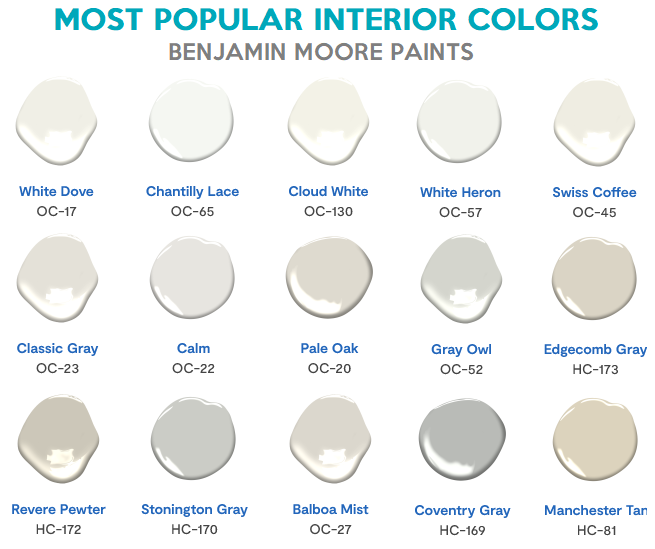
NEUTRAL ≠ BORING
Sometimes all neutral-colored walls can make a home feel boring or stale. This is especially true with older homes, homes with older furniture, or homes without a lot of natural light.
Instead of painting an accent wall, an easier idea is to simply add accent PIECES.
Colorful accessories like couch pillows, area rugs, a vase or lamp, or even a house plant can provide a nice contrast and give life to a dull room.
PAINTING OVER WALLPAPER
It's possible to paint over wallpaper using an oil-based primer first. Budget plenty of time to dry, especially in humid climates.
ADD SOME LIVE PLANTS
And get rid of fake plants.
CLEAR THE COUNTERS
This includes counters and tabletops in every room.
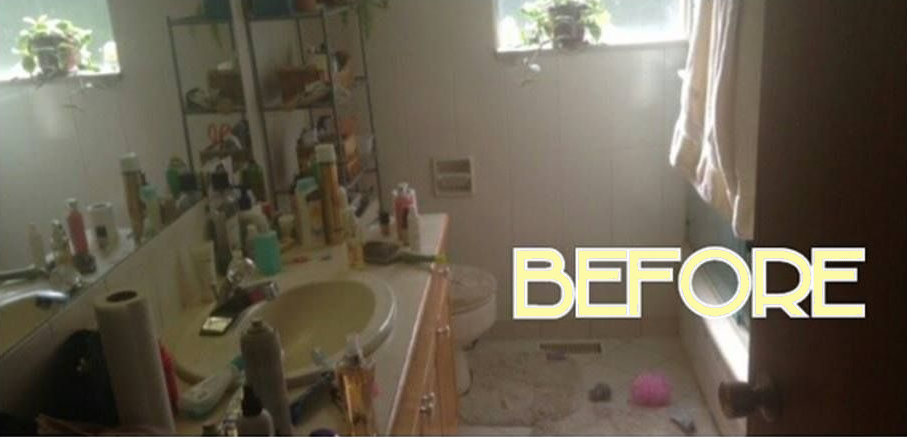
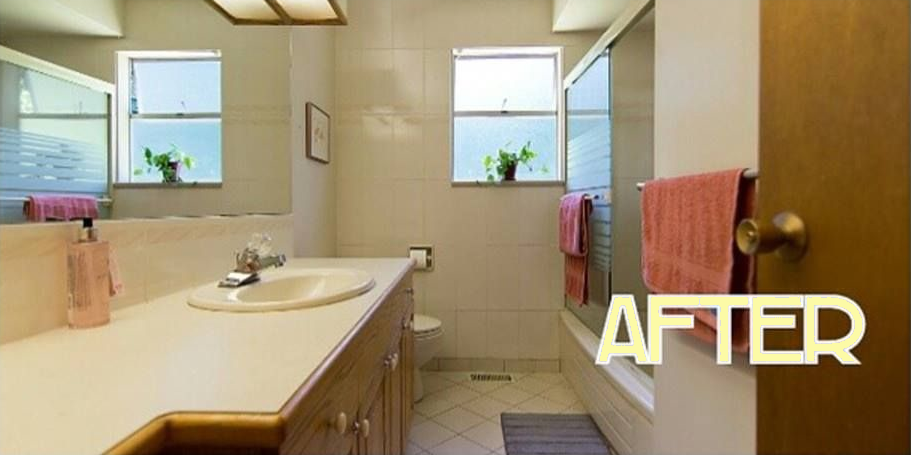
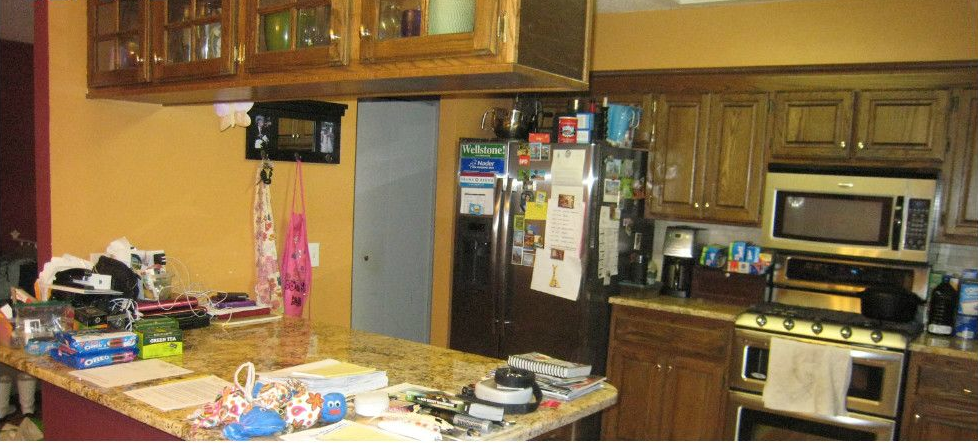

SCRUB THE BATHROOMS
This is important. A negative reaction to the bathroom usually leads to a negative view of the home overall.
CLEAN THE WINDOWS
Here’s a tip: Professional window cleaners don’t use products like Windex. Many simply use dish soap, like Dawn or Palmolive. It’s true! They might add some other products to make the squeegee glide better, but you can get by with some water and dish soap.
KEEP YOUR CLOSETS HALF FULL
This way they'll appear to have more space.
HIDE OR LIMIT KID & PET ITEMS
The buyers may be parents or pet owners, but they'll want to picture themselves in the home.
MAKE ENOUGH SPACE FOR TWO PEOPLE TO WALK THROUGH
Couples tend to walk through rooms side-by-side. Be sure there is enough space for two people to walk freely through your home.
ADDITIONAL RESOURCES
CURB APPEAL
"You only get one chance at a first impression."
You've heard this phrase before, with good reason - it's true. Researchers have found that homes with high curb appeal sell for 7% more than homes with low curb appeal.
Nice curb appeal doesn't need to be a lot of work. Keeping the lawn mowed and green goes a long way. Here's some other tips:
YELLOW SAYS...
BUGS
Bugs can be a problem, from outside pests like ants to inside pests like roaches.
A good product we use is called Talstar. It kills everything from roaches to termites to mosquitos to ants. We spray it outdoors, but it can be sprayed indoors, too.
We spray every couple months and a gallon lasts for years. The cost is reasonable at around $60 (a pint goes for about $35) and a sprayer is required.
ADDITIONAL RESOURCES
TV SHOWS ON STAGING
Sell This House!
This is a good show that helps homeowners stage their home at a very low cost. It definitely has a lower budget than something you'd see on HGTV, but we feel like it’s more realistic.
You can find old episodes on the 'Dabl' and 'FYI' networks, which are on many cable carriers. Newer episodes can be found on the 'FYI' network. You can also find episodes to watch online in the links below.
PROFESSIONAL STAGING COMPANIES
There are many reasons to use a professional stager, and not just for their expertise. It’s helpful to get an outside perspective, since many home sellers can’t look at their home objectively and see what needs to be done.
The cost of a professional is not cheap – however, their service is likely to result in a faster sale with a higher price, so it may pay for itself and more.
Average cost, from Home Advisor:
We suggest considering an initial consultation to get advice on what should be done and do it yourself if you think you can.
ADDITIONAL RESOURCES
RENOVATIONS
We caution sellers before making big renovations.
Sellers often make upgrades to their home before selling in order to fetch a higher sale price. They may get a higher sale price, however, it usually isn't for more than they spent on the renovation. That makes it a net loss.
Sellers are usually better off not making big renovations and instead, pricing the home lower to appeal to more buyers who can customize it to their tastes.
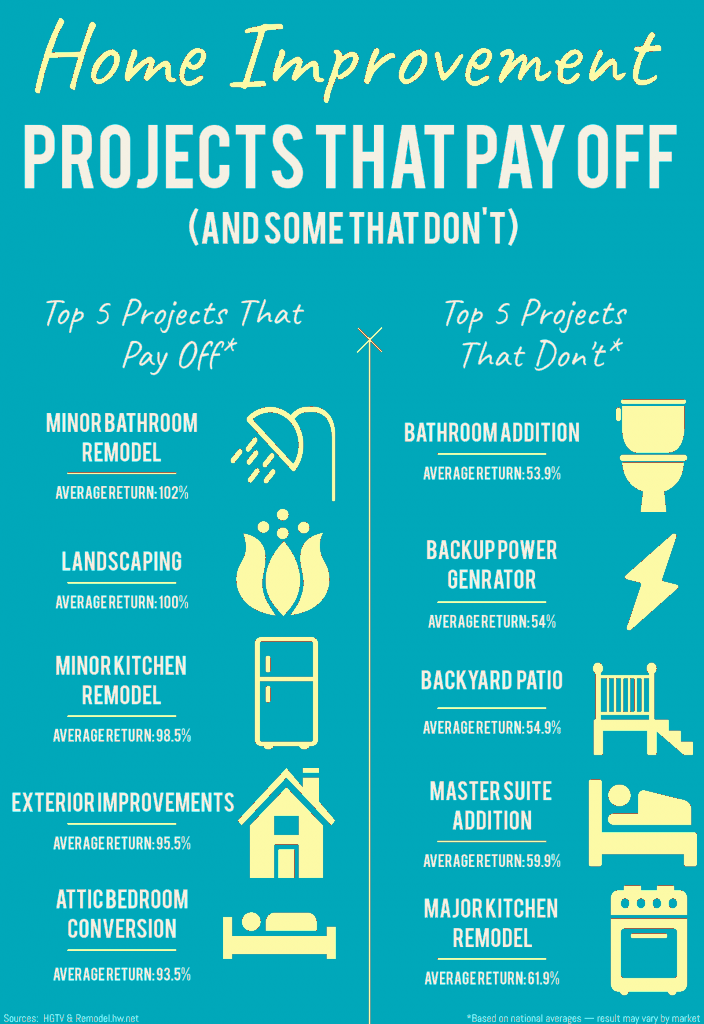
Source: dyernews.com
ADDITIONAL RESOURCES
- PICTURES -
These are the most important part of your listing. Be sure to invest some extra time here to do a good job.
Once you’re comfortable with your home’s appearance, it’s time to take the pictures that will appear in your listing. Studies have shown that the pictures were the most important thing potential buyers looked at, so you want to get this right.
YELLOW SAYS...
YELLOW HELPS WITH PICTURES
YELLOW uses professional software to create more flattering and realistic photos of your home. We only do minor touch-ups because we believe some photos are edited so much that they don't reflect the home's actual condition.
Several examples have been included below.
Here we adjusted the color to look more appealing, while remaining realistic.

We can straighten the image and remove reflections.

Here we sharpened up the picture and removed a few distracting items. Can you find the differences?

In this picture we removed the reflection and cleaned up the colors.

Here we lightened up the shadows.

The following pictures were taken with an average camera in a home with no power - and therefore, no lights. We adjusted the colors and straightened the images.



PHOTO TIPS
RANKING OF PICTURE QUALITY
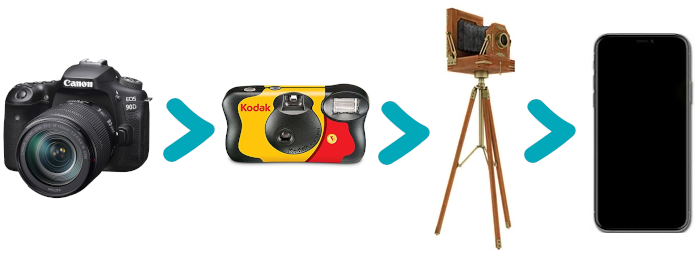
A tongue-in-cheek way of saying mobile devices should be a last resort.
CAMERA
It's important to use the best camera available to you.
The highest quality photos will come from DSLR or mirrorless-style cameras. Point-and-shoot digital cameras can produce nice pictures, too. Modern cell phones can sometimes produce nice images, but should only used as a last resort.
Cell phone cameras are so popular and it's an uphill fight for us against them. Therefore, we've included several links to help get the best pictures out of them. Our biggest tip is to please never zoom in with the cell phone camera!
PHOTO-TAKING TIPS
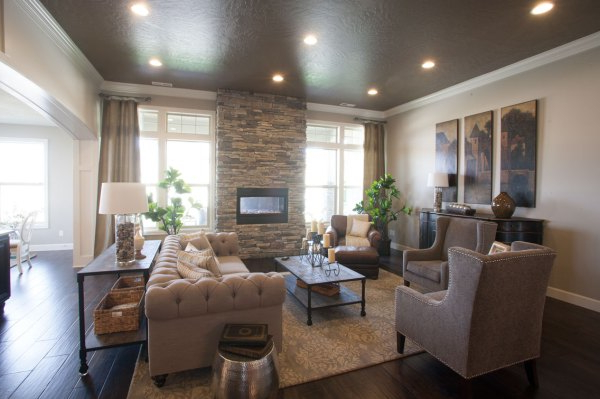
Too much light can cause glares
To prevent too much light from ruining a shot, pay attention to the time of day you are taking pictures.
Indoor pictures should be taken when the sun is bright, but you don't want sunlight coming in through the window.
Outdoor pictures look best taken when the sun is lower and behind the cameraman since it reduces the shadows on the home.
Many people also take a twilight picture of the home when the sky is darker but all the curtains are open and the lights are on. This also helps show off any landscape lighting.
PHOTOGRAPHY TIPS, FROM ZILLOW
ADDITIONAL PHOTO TIPS
AIRBNB PHOTO TIPS FOR HOME RENTERS
These tips are applicable to home sellers, too.
HIRING A PROFESSIONAL PHOTOGRAPHER
Should you hire a professional photographer?
This is a common question.
You want your pictures to look as good or better than homes listed near you and at your price level. Check on any real estate website - do those pictures look better than yours? Do they look professional? If so, you should consider hiring a professional.
The consensus is the more expensive your home, the more likely you should use a professional.
A simple internet search in your area will go a long way to finding a good photographer.
YELLOW SAYS...
MISTAKES TO AVOID
Most bad photos are due to a lack of attention to details.
Don’t get any people in your shot - including yourself. This includes reflections and shadows. Even little things like leaving the toilet seat up can ruin a picture.
There are websites devoted to bad real estate pictures. Try not to end up here.
- VIDEOS -
Video is a great way to give buyers a realistic look at your property.
Sellers on YELLOW can upload a video walkthrough of their home, but it is not required. The video can be as simple as walking through your home with your cell phone.
YELLOW SAYS...
YELLOW HELPS WITH VIDEO
YELLOW uses professional software to remove bumps and vibrations, clear up the picture, and adjust coloring.
We keep your video silent, removing all sounds and do not add music. We've found the autoplay function on many web browsers will not play a video if it has music.
The video below was shot at our corporate headquarters with a simple iPhone and no lighting or staging. We made minor adjustments to the footage to make a cleaner, smoother, and more realistic video.
VIDEO TIPS
VIDEO CAMERA QUALITY

All recording devices can provide nice video - even the phone.
TIPS FOR GOOD VIDEO
- PROPERTY DESCRIPTION -
The purpose of the description is to highlight desirable things the buyer can’t see from the pictures. The most important thing is to be honest and don’t overhype your home – exaggeration is easy to see and can turn buyers off.
YELLOW offers two ways of writing a description:
USE THE YELLOW AI TO WRITE IT FOR YOU
Simply enter a few keywords and the AI will generate a listing for you. The results are pretty good! We suggest using the response as a draft and modifying or expanding it as you see fit.
Additionally, sellers can look into using ChatGPT to create the listing description. https://chat.openai.com/
WRITE YOUR OWN
For sellers looking to write their own description, we’ve provided some tips below.
WRITING A DESCRIPTION
Real estate websites like Zillow may still have your home’s description from when it was last sold. Look to that that as a guide for what to include, but do not copy the old description! You can be charged with copyright infringement. (This applies to the photos, too.)
It's also helpful to check out descriptions for other homes in your area for ideas. Again, do not copy.
Important note - the Fair Housing Act prohibits discrimination based on race, color, religion, national origin, gender, disabilities, or familial status. Be careful to avoid using terminology that even alludes to these issues. A violation can be as simple as noting the home is near a church. Be cautious here.
DESCRIPTIVE REAL ESTATE WORDS
Check out these links to helpful adjectives and keywords that can enhance your listing:
DESCRIPTION STRUCTURE
OPENING
The intro tries to capture the reader’s attention. Descriptive adjectives like the ones found in the links above can be helpful.
CORE
This section highlights the features and tells readers what it’s like to live in the home.
Use words that help buyers picture themselves living there. Rather than just a list of features, describe the benefits of those features. It’s okay to stay concise and factual.
A rule of thumb is to touch on the main points in the order your pictures appear (starting in the front of the home, moving inside to the living room, kitchen, bedrooms, then to the rear of the home).
Be sure to note any upgrades, renovations, or improvements you completed.
Highlight any special features of the home, like hardwood floors, marble countertops, tile showers, insulated windows, solid wood doors, nice views, outdoor areas, etc.
Also include name brands of premium appliances, windows, and doors (like Viking, Sub-Zero, Thermador, etc.) as this indicates quality.
Note any nice neighborhood or location features, too. The home may be close to certain districts or attractions, or maybe have amenities nearby like walking trails, parks, or a community pool. Also note a highly-rated school system if it is in your area (this must remain fact based, like "A-rated schools." Subjective terms like "good" can violate the Fair Housing Act).
CLOSING / CALL TO ACTION
The closing conveys a sense of excitement or urgency that can help prod buyers to act. Sometimes this section can be harmful if it sounds too cheesy, but it is helpful if done well.
Don’t forget to mention that by using YELLOW, you are helping buyers save time and money!
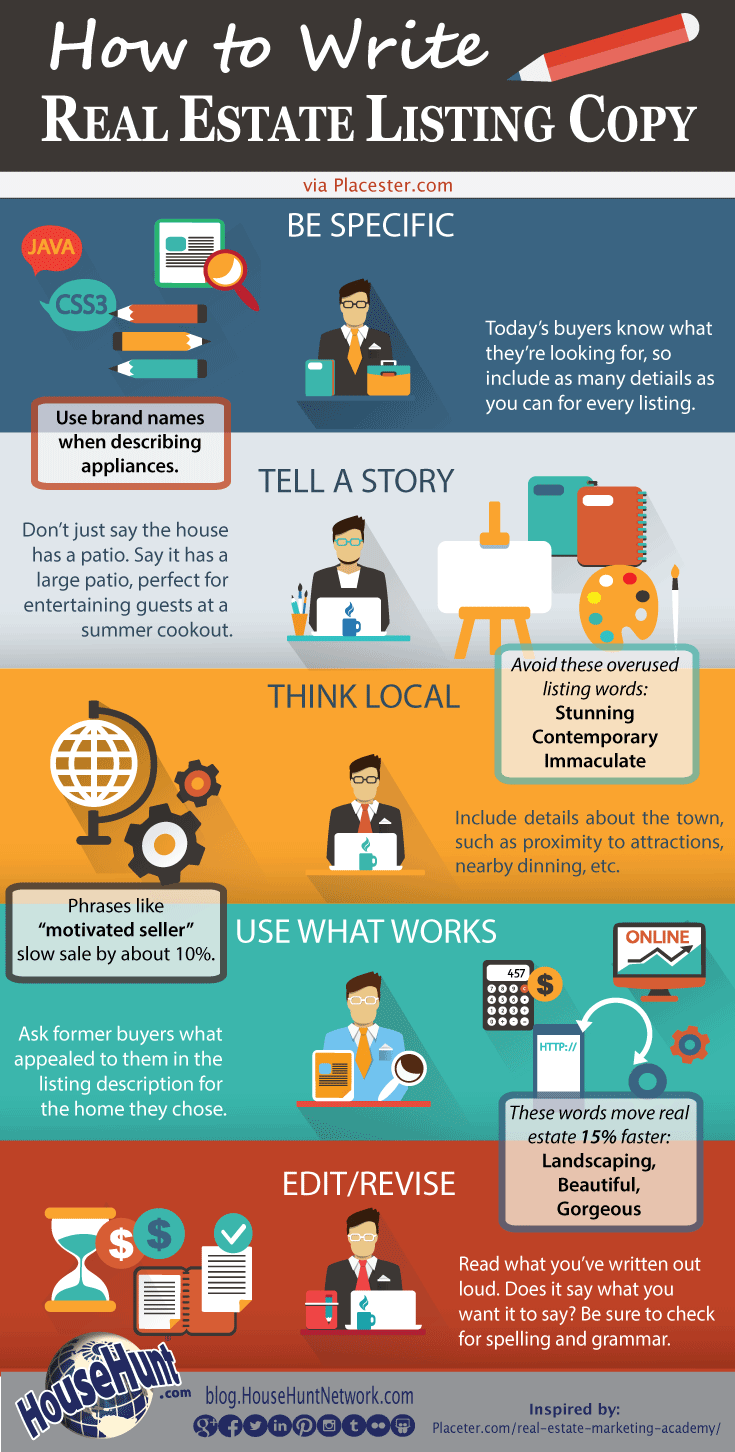
House Hunt Network How to write real estate copy
ADDITIONAL RESOURCES
- MLS -
In order for your home to appear on websites like Zillow or Realtor.com, the home must be in the MLS. Those websites get their data from the MLS.
YELLOW will enter your home in the MLS, but it is very important to explain the MLS first.
THE MLS
The MLS is not one large database of homes for sale. There are many different MLS’ run by the Realtor organization in a certain geographic area. By our count, there are over 30 different MLS organizations in the state of Florida. That means we must pick one MLS to enter your home.
YELLOW'S MLS
YELLOW uses the MLS of Northeast Florida. That means if the buyer is using a Realtor, your listing will only appear in their searches in the Northeast Florida region.
If your objective is to get your home in front of buyers on websites like Zillow, this will not be an issue. Your home will appear in those websites.
If you wish to appear in Realtor searches in another part of the state, we will need to contact that region's MLS. Each MLS differs, but all will require an extra fee and some may not permit outside listings. Any MLS cost will be paid to that MLS and YELLOW DOES NOT profit from this.
We’ll work with you to get your listing in front of as many buyers as possible.
The MLS' in FL
Different MLS’ have different area coverage. For example, Miami has an MLS that covers the Miami area up to West Palm, but central Florida has an MLS that stretches from Gainesville down past Sarasota.
- DISCLOSURES -
Sellers are legally required to make disclosures about their home. This is true even when selling a home on your own.
YELLOW has built the disclosures into the process when you list your home, so there are no additional documents to complete.
Sellers will receive a completed copy of these forms after the home is listed on YELLOW.
SELLER’S PROPERTY DISCLOSURE
By law, sellers must disclose any material defects of the home that they are aware of.
This only applies to issues you know about.
You aren't expected to know about everything, especially inside the walls. But you could face legal trouble if the problem is something obvious - like a leaky roof - and you don't disclose it. It is very important to be honest here.
ADDITIONAL RESOURCES
DISCLOSURE TEMPLATES
The blank disclosure forms for both houses and condos can be found below.
SELLER
DISCLOSURE
HOUSE
SELLER
DISCLOSURE
CONDO
CONDO RIDER
Condo owners must disclose details about the association and the fees charged.
A blank copy of this form can be found below.
HOA DISCLOSURE
Homes with HOA's must disclose details about the association.
A blank copy of this form can be found below.
LEAD PAINT DISCLOSURE
The federal government requires that buyers of homes built before 1978 be aware that lead paint may be present in the home. This does not mean this home has lead paint present. All homes built before 1978 are required to have this notification.
A blank copy of this form can be found below.
ADDITIONAL CONDO DISCLOSURES
Condo sellers are required to provide additional documents, which sellers may recall from when they purchased the condo.
Here are the documents that are required:
AFTER SUBMITTING YOUR HOME ON YELLOW
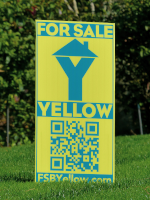 Once you’ve entered your home’s info and uploaded the pictures, it won’t immediately go live (where it appears on our website, the MLS, and other real estate websites).
Once you’ve entered your home’s info and uploaded the pictures, it won’t immediately go live (where it appears on our website, the MLS, and other real estate websites).